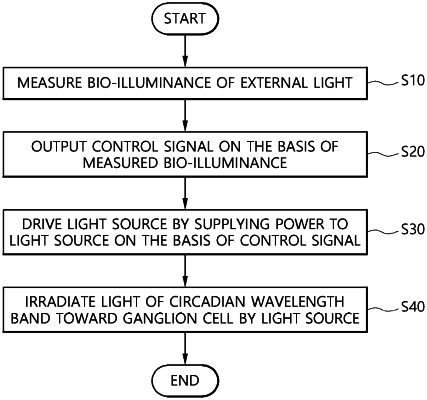| CPC A61N 5/0618 (2013.01) [A61M 21/00 (2013.01); A61M 21/02 (2013.01); A61B 5/4857 (2013.01); A61M 2021/0005 (2013.01); A61M 2021/0044 (2013.01); A61N 2005/0636 (2013.01); H05B 44/00 (2022.01)] | 12 Claims |

|
1. A circadian rhythm correcting apparatus comprising:
a bio-illuminance measurer configured to measure bio-illuminance of external light using a circadian lambda filter that passes the external light according to a circadian sensitivity curve;
a light source configured to be disposed around a user's eyes and configured to irradiate light mixed with a blue wavelength band and a cyan wavelength band toward a ganglion cell;
a light source driver configured to drive the light source by supplying power to the light source;
a controller configured to control the light source driver on the basis of the bio-illuminance measured by the bio-illuminance measurer;
the circadian sensitivity curve being a light sensitivity characteristic curve for a hormone that controls the circadian rhythm and is a curve having the maximum sensitivity in a circadian wavelength band; and
an alarm part configured to provide an alarm so that a user may escape an environment in which melatonin secretion is suppressed when the bio-illuminance is equal to or greater than 350 blx;
wherein the controller compares the bio-illuminance with reference bio-illuminance and outputs a control signal corresponding to a value of a difference between the bio-illuminance and the reference bio-illuminance to the light source driver, and
wherein the reference bio-illuminance is an illuminance value required to maintain a regular circadian rhythm, and varies according to a circadian time.
|